Tips and how to travel to Saudi Arabia in 2022
0 View
Share this Video
- Publish Date:
- August 24, 2022
- Category:
- HOW TO -
- Video License
- Standard License
- Imported From:
- Youtube
Tags
Sponsored Area
TODAY'S ADVENTURE
Tips and how to travel to Saudi Arabia in 2022>Want to travel to Saudi with Against the Compass? JOIN our EXPEDITION: November 12th to 19th (2022) CLICK HERE TO LEARN MORE
Once one of the most difficult countries to visit, Saudi Arabia is finally issuing visas for tourism purposes and independent travel.
Before, the only way to travel to Saudi was on a business visa, via a strong local connection who could sponsor your visit, or by getting a pilgrimage visa to visit Mecca and Medina (only for Muslims).
Therefore, the fact that all of a sudden, Western tourists can visit Saudi Arabia on their own, with a backpack, both men and women, is a very radical change.
This incredibly big change, however, didn’t come alone.
During the last couple of years, a lot of their super strict Islamic laws have been softened or, at least, they have become more flexible. For example, allowing women and men to hang out together in public spaces was one of the most significant changes.
All these small changes will make things easier for future international visitors.
Despite everything that you may have read in the media, Saudi Arabia is an incredible country. There is just so much to do and see, a country filled with loads of stunning sites, both natural and archaeological, hugely contrasting landscapes and some extremely hospitable people that could easily rival my beloved friends from Afghanistan Pakistan and Iran.
I strongly believe that this is the most underrated country on this planet, and here I have compiled a comprehensive travel guide to Saudi Arabia packed with tips and everything you need to know to travel to the Kingdom.
This guide contains all the practical information. For places to visit read my Saudi Arabia itinerary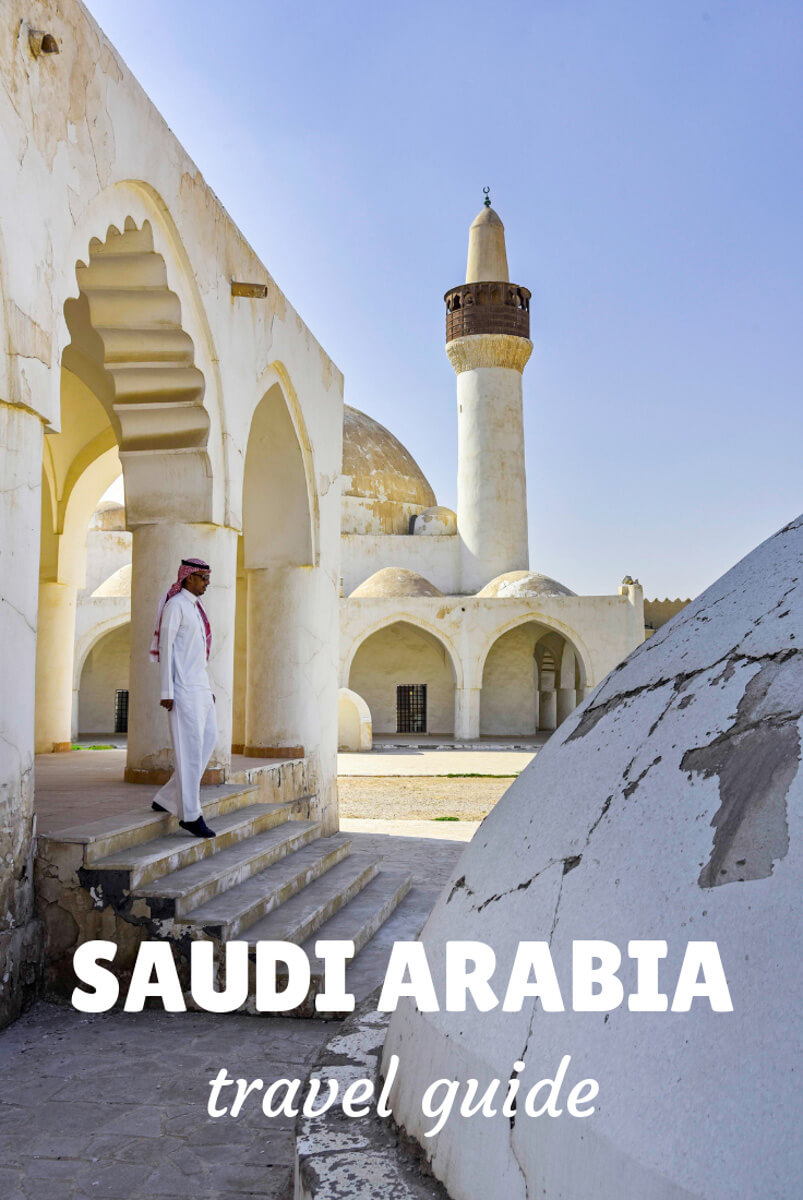
In this Saudi Arabia travel guide you will find:
COVID-19 travel restrictions Visa Tours Travel Insurance Best time to visit Top experiences Getting to Saudi Tourism in Saudi Arabia Is it ethical? Blocked websites How to behave
Rules to followMiss conceptionsSaudi people The food Solo female travel Safety Money Moving around Saudi Internet and SIM Card Accommodation More information
In Saudi Arabia, the internet is censored, which means that some websites and internet services are blocked. If you want to access them you will need a VPN and for that, I recommend ExpressVPN, the fastest and works best for Saudi. CLICK HERE TO LEARN MORE ABOUT ExpressVPN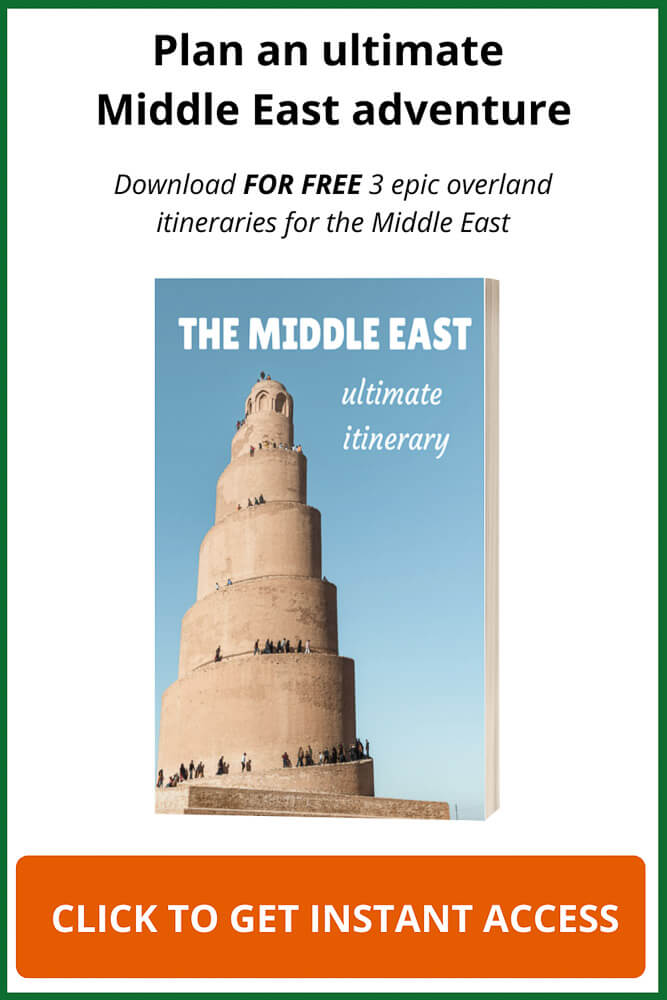
COVID-19 travel restrictions for Saudi Arabia
Saudi Arabia reopened its borders in August 2021.
As of today, these are the COVID-19 entry requirements for traveling to Saudi Arabia:
Certificate of vaccination (2 shots)Travel insurance (purchased along with your visa)Once you got your visa, you must register your vaccination details on the government portal, no later than 72 hours before departure.
Furthermore, upon your arrival in Saudi Arabia, you will have to register on Tawalkkana, an app that contains your COVID-related profile, and which you need to show to enter most restaurants, shops, or even for taking domestic flights.
The app, however, is full of bugs and my first piece of advice is that you should not take it very seriously. For example, in my case, the app always indicated that I had to quarantine so instead, I would just show my vaccination certificate, and it was always OK.
Please check the official tourism board website for more COVID-19-related information.
Travel Insurance for Saudi Arabia with COVID-19 coverage
IATI Insurance is one of the few providers that offers full Coronavirus coverage, not only when it comes to treatment, but also cancellations costs in case you tested positive before departure. Moreover, remember that health care costs in Saudi Arabia are crazy expensive, so travel insurance is a must.Readers of Against the Compass can get an exclusive 5% discount.BUY IT THROUGH THIS LINK TO GET YOUR SPECIAL DISCOUNTHow to get a visa for traveling to Saudi Arabia
For visiting Saudi, you can apply for an e-visa through visitsaudi.com
This is what the tourist visa for Saudi looks like.

My visa for Saudi Arabia
Which countries are eligible to visit Saudi with tourist e-visa?
All EU countries + Andorra, Iceland, Liechtenstein, Monaco, Montenegro, Norway, San Marino, Switzerland, United Kingdom, and Australia, Brunei, Canada, China, Japan, Kazakhstan, Malaysia, New Zealand, Russia, Singapore, South Korea, Ukraine and United States,How to apply for Saudi tourist e-visa
Applying for the e-visa is pretty straightforward and you can do it through this portal.
Just follow the steps, and you will be on the way.
How much does it the Saudi e-visa cost?
Total visa price is 535 Saudi Rials, which is around 142 US Dollars.
From that amount, 180 Saudi Rials refer to the Saudi travel insurance, a COVID-related requirement.
How long is it valid for?
The visa allows you to stay in Saudi for 90 days, and it has a 1-year validity from the issuance date.
It’s also multiple entry.
This means that, within a year, you travel to Saudi as many times as you want with the same visa, as long as your stay doesn’t exceed more than 90 days.
Can single women apply for the same Saudi e-visa?
Yes, they certainly can, no restrictions for being a female.
Don’t forget to read my 2-week itinerary in Saudi Arabia.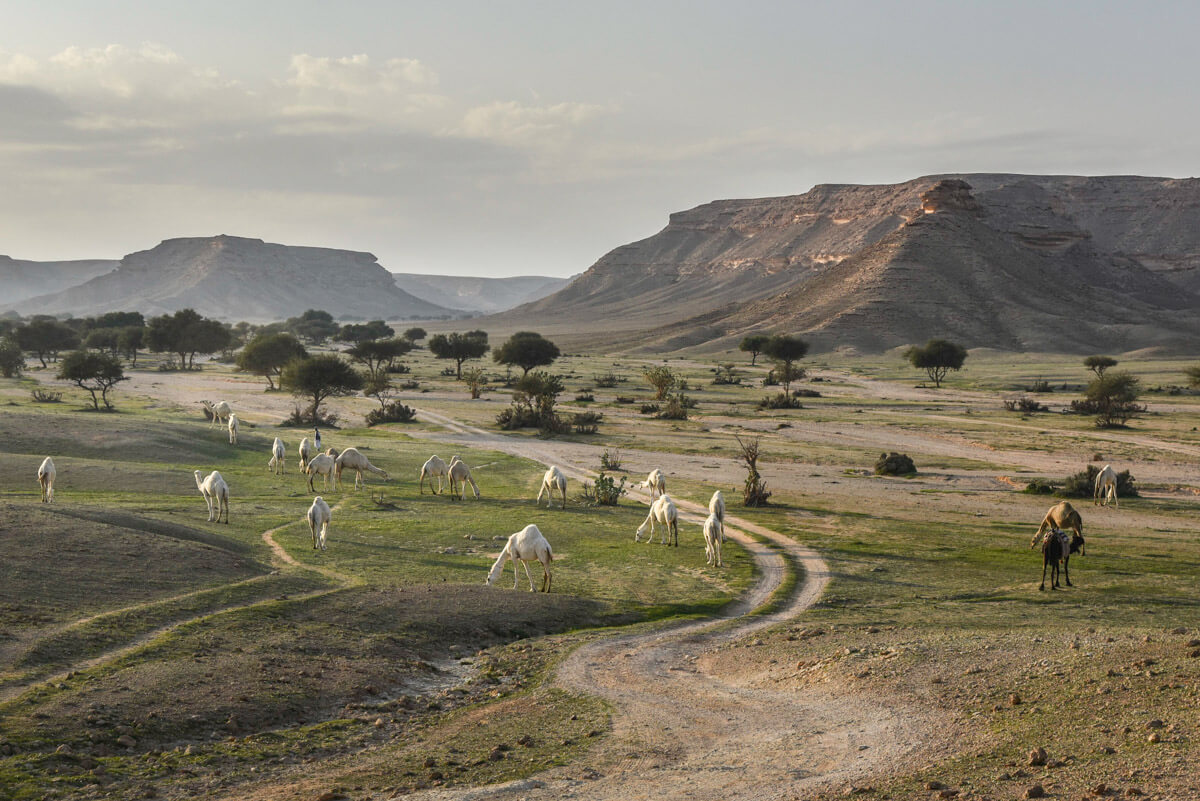
Outside of Riyadh, on the way to the Edge of the World, one of the highlights of any trip to Saudi Arabia
How to sign up for a tour in Saudi Arabia
Traveling with a group and like-minded travelers is always a lot of fun!Against the Compass has 2 expeditions to Saudi scheduled in 2022:November 3rd to 10th – SOLD OUT!November 12th to 19th – APPLY NOW!In this epic 8-day expedition, we will visit places like: Jeddah, Yanbu, Medina, Al-Ula, Wadi Disah, Tabouk and more!Why join our Saudi EXPEDITION?Because we will do plenty of activities which otherwise would be impossible to do on your own, like:Sailing to an island in the Red SeaCamping with actual Saudi BedouinsDriving across the desert around taboukVisiting Holy City of MedinaDriving around the archaeological site of Al-Ula with a vintage Jeep carAll details can be found here: SAUDI Expedition November 2022Get this epic travel guide to Saudi Arabia!
My friends Sian & Bob have recently published a full guidebook to Saudi Arabia, containing loads of actionable advice and a great overview of each one of their regions. A great introduction to the country, this must be the only available travel guide to Saudi Arabia!CLICK HERE TO GET YOUR PRINTED COPY!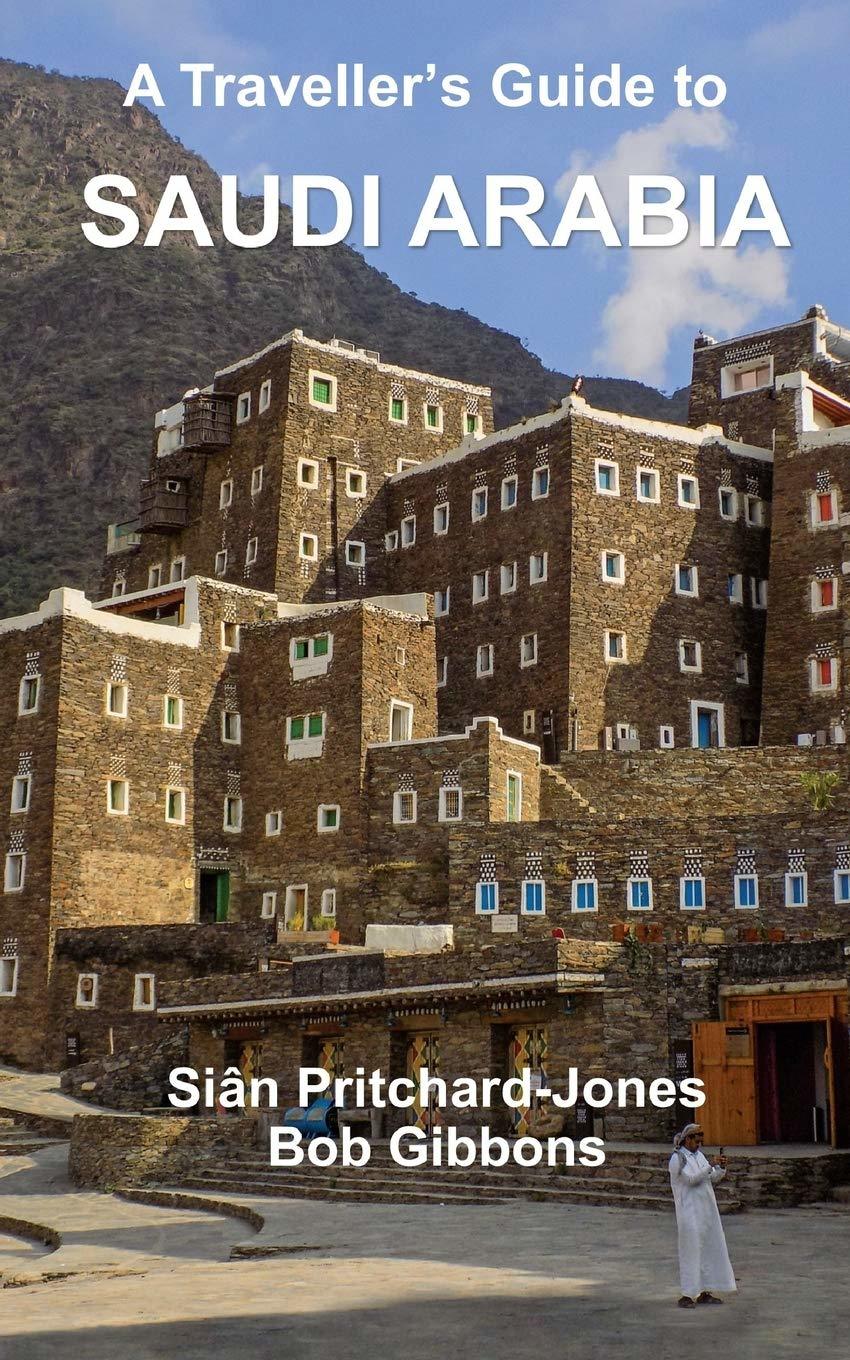
Travel Insurance for Saudi Arabia
In Saudi Arabia the Health Care System is private and crazy expensive, so do get proper travel insurance. I strongly recommend IATI Insurance because:It covers up to 5 million € of medical expensesOne of the few providers with full COVID-19 coverageCovers senior citizens tooReaders of this blog can get a 5% exclusive discountGET IT HERE TO GET YOUR 5% EXCLUSIVE DISCOUNT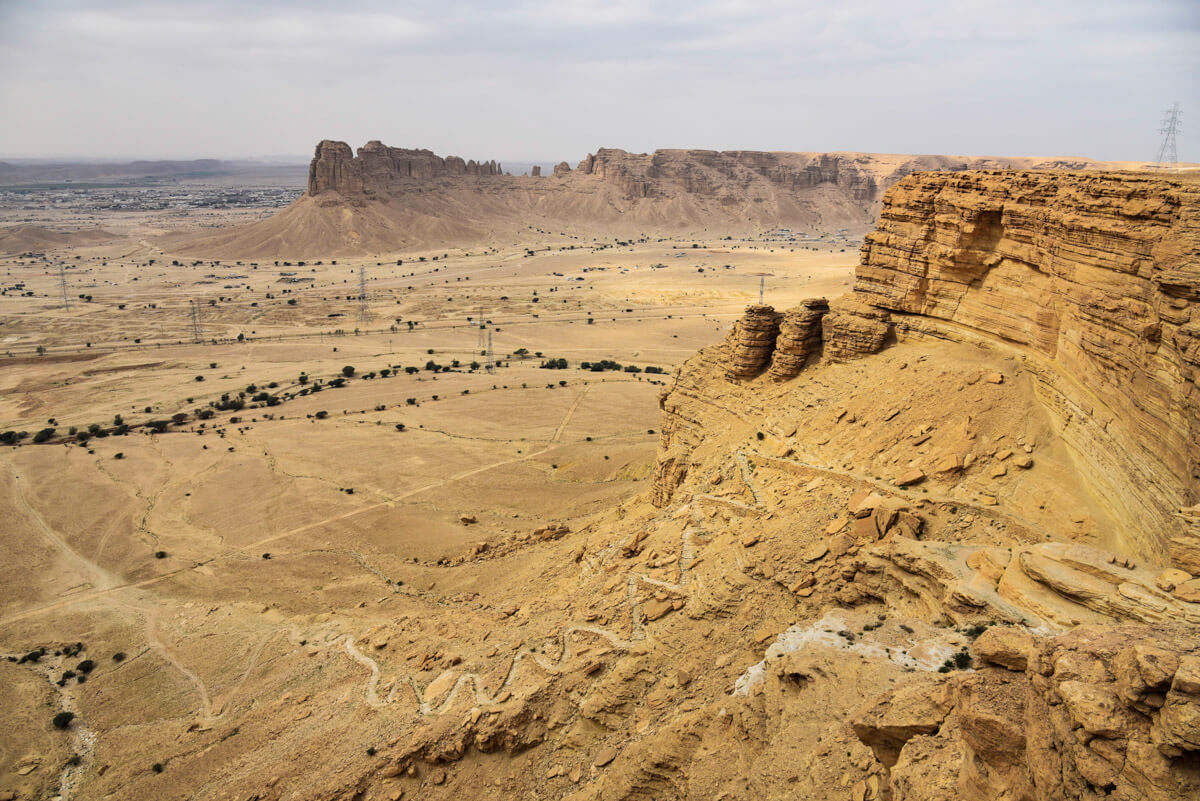
Another very cool canyon outside of Riyadh
Best time to visit Saudi Arabia
The best time to visit Saudi Arabia is during the cooler months, from November to February.
March, April and October could be bearable but outside this ”winter season”, the country could be too hot to enjoy.
By the way, note that the north of Saudi Arabia can be extremely cold in winter, with temperatures below 0ºC in transited regions such as Al-Ula and Tabouk.
5 Top things to experience in Saudi Arabia
Visiting Mada’in Saleh, like Petra but more epic
Mada’in Saleh is an archaeological complex composed of hundreds of tombs carved out from rocks and scattered across the desert. Mada’in Saleh was founded by the Nabateans, the same civilization that built Petra.
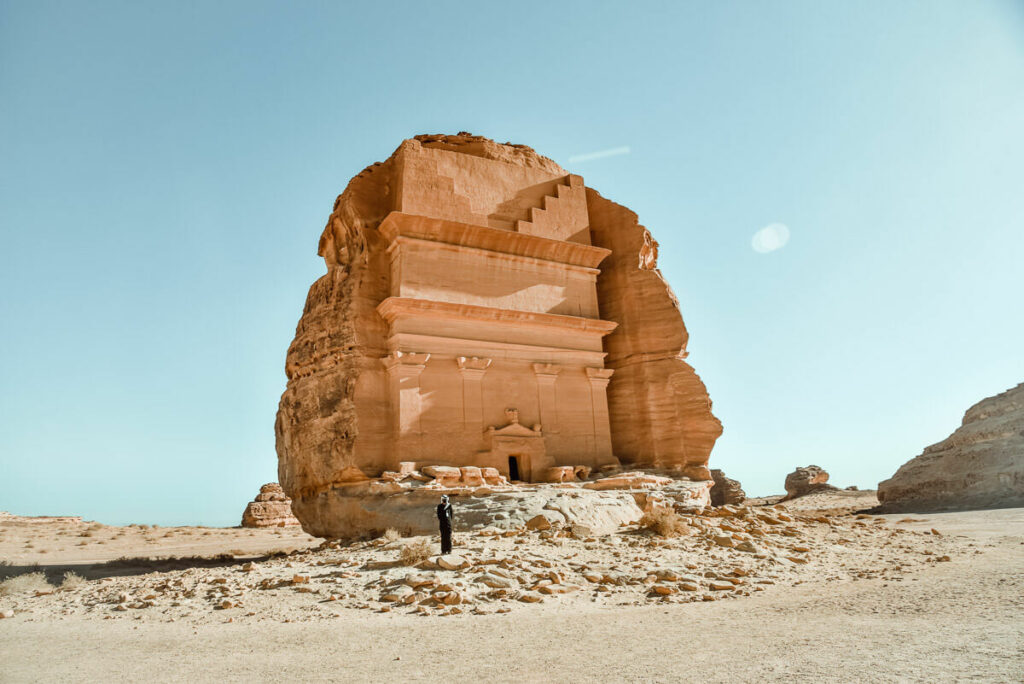
Mada’in Saleh, Saudi Arabia, is a must-visit during your Saudi Arabia trip
Being one of the first tourists to ever visit Medina, the second holiest city in Islam
The city of Medina had remained off-limits to non-Muslims for decades but from 2022, Western tourists are allowed to visit the city, as long as you stay just at the entrance of the Holy Mosque, the place where Prophet Mohammed is buried.
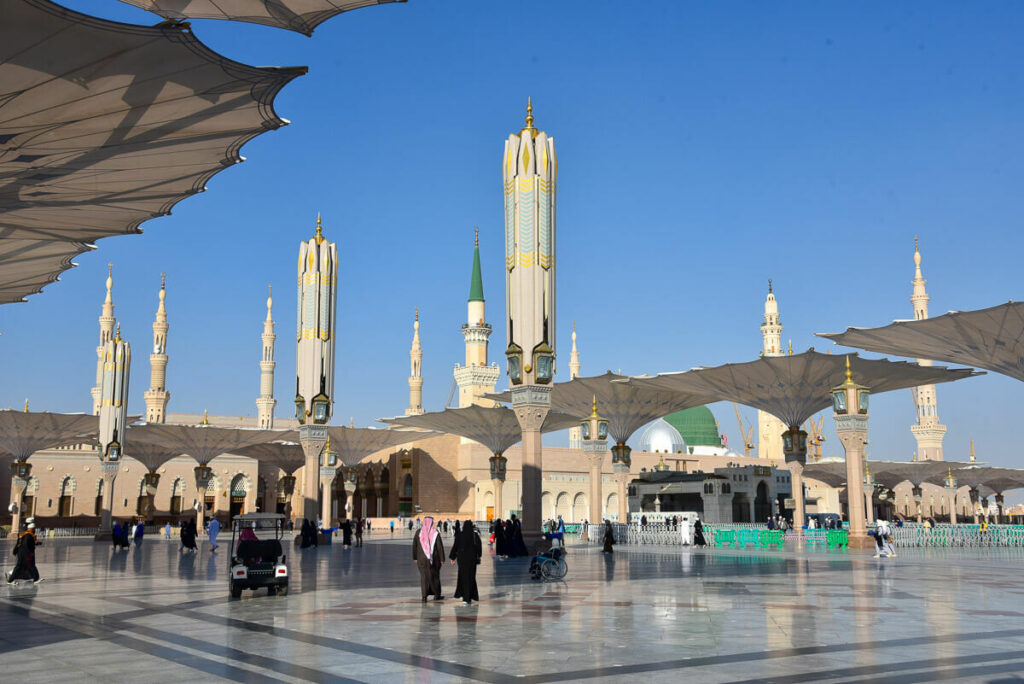
Just outside of the Holy Mosque of Medina
Exploring Fayfa, a region of Saudi Arabia with Yemeni-like culture
Fayfa is a southern region bordering Yemen that historically, had been part of Yemen, so several aspects of their culture – including the way they dress and their cuisine – have remained.
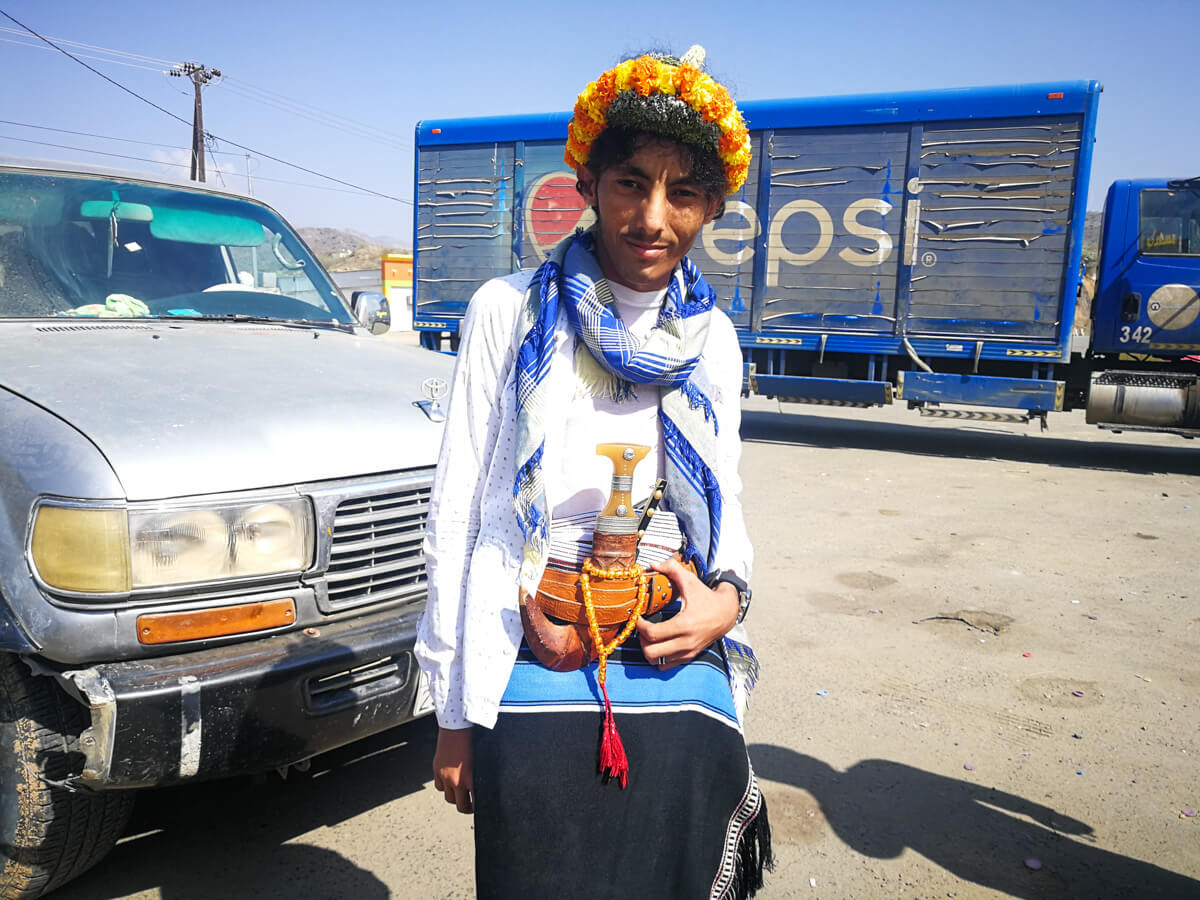
A Yemeni-like Saudi man from Jizan
Discover the natural wonders from Tabouk region
Tabouk is a northern region bordering Jordan home to incredible wadis, rock formations, deserts and Bedouins.
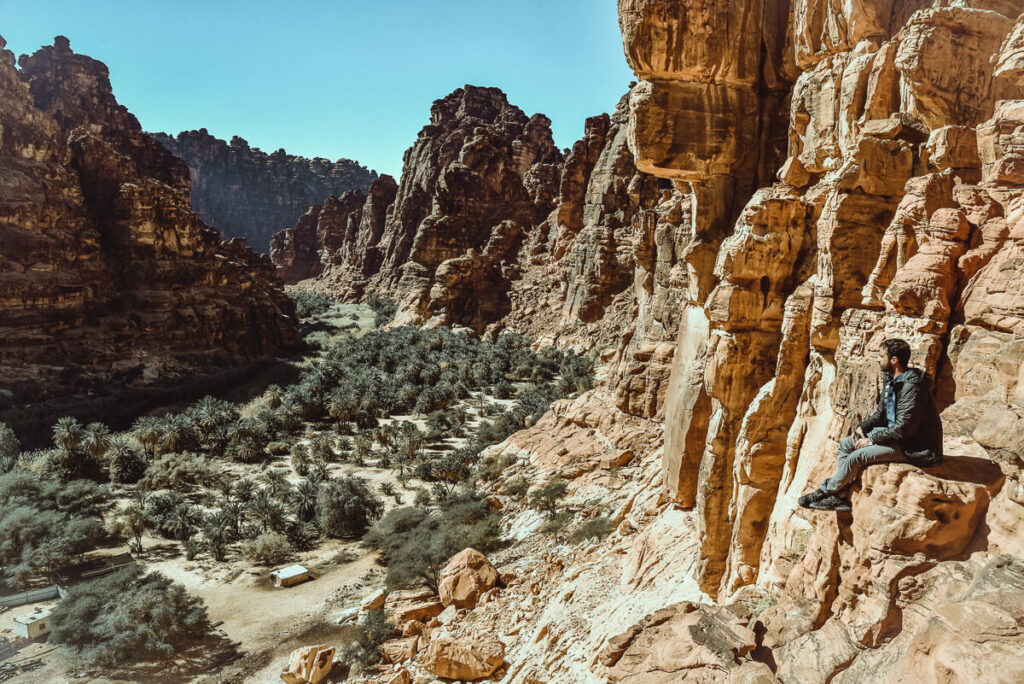
Wadi Disah, in Tabouk area
Snorkelling in the Read Sea
Everybody knows about the beauty of the Red Sea, the reason why Egypt has become a prime diving destination. However, few people know that the same coral reefs can also be found along the Saudi Arabia coast, and I particularly like the area between Yanbu and Umluj.
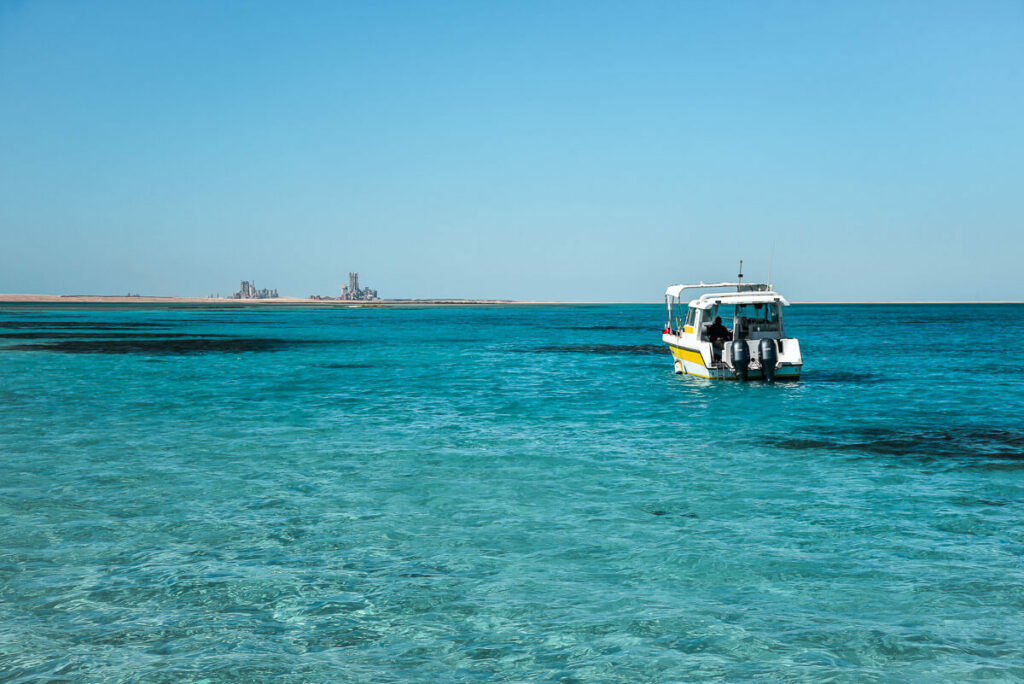
The Red Sea coast near Yanbu
How to get to Saudi Arabia
Remember to get travel insurance for Saudi Arabia Saudi Arabia’s health care is extremely expensive, so insurance is a must. IATI Insurance offers different plans, for all budgets. Get your 5% exclusive discount if purchasing via this linkHow to travel to Saudi Arabia by air
The easiest way to travel to Saudi Arabia is by flying in. There are loads of international flights, especially to Jeddah and Riyadh.
Saudia Airlines has many direct flights from Europe and other destinations, while other airlines like Pegasus or Emirates fly there via Istanbul and Dubai, respectively,
How to travel to Saudi Arabia by land
As long as you have a valid visa for traveling to Saudi, getting in to the country by land is totally doable.
Saudi Arabia shares a border with:
United Arab Emirates – Easy to cross.Oman – The desert road that goes through the Empty Quarter, linking Oman and Saudi was recently open. This border crossing can be quite an adventure. Read my Oman travel guideQatar – Should be easy to cross, now that the displomatic relations between both countries have normalized.Bahrain – Easy to cross. Iraq – Since March 2021, it’s now possible to travel to Iraq, so overlanding into Saudi shouldn’t be a big issue.Jordan – Easy to cross. Yemen – Not possible to cross.Read: A guide to finding the best area to stay in Dubai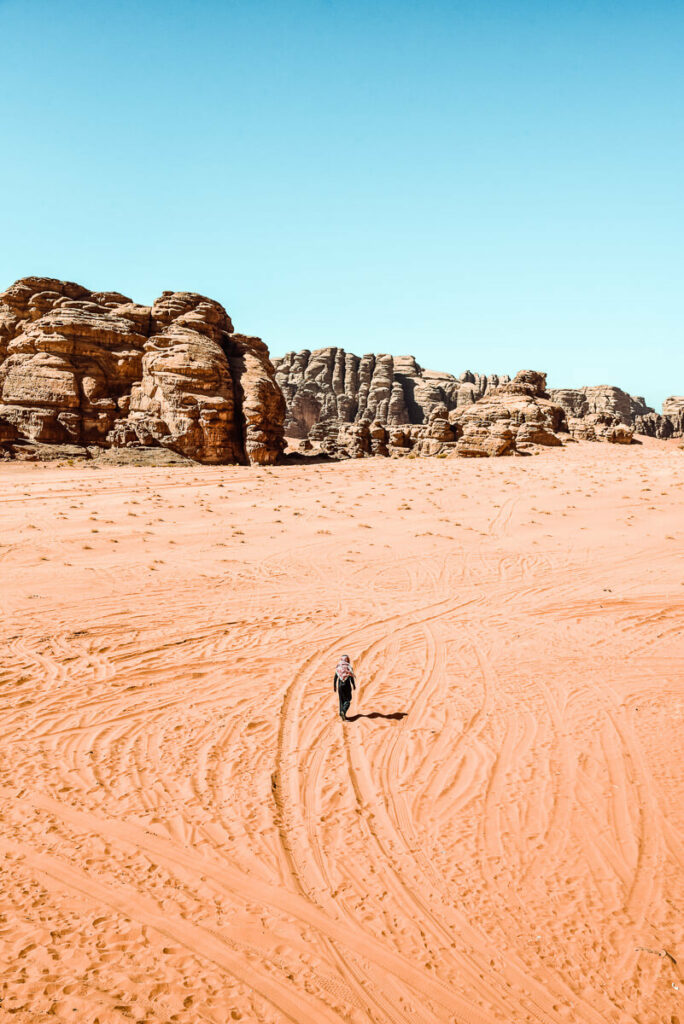
In the north of Saudi Arabia, close to the border with Jordan, you find Wadi Hisma which is essentially the continuation of Wadi Run in Jordan. Same landscapes, same Bedouin culture but without tourists
Tourism in Saudi Arabia, what is it like
Interested in off-the-beaten-track countries? Check: Somaliland travel guide Eritrea travel guideAs you may imagine, tourism in Saudi Arabia is in a very embryonic stage.
Random Saudi:Where are you from?
Me:Spain
Random Saudi:Where do you live, in Jeddah or Riyadh?
Me:Nowhere, I am just visiting 
Random Saudi:No, I mean where in Saudi are you working?
I had this conversation over and over. They still don’t know that foreigners can now travel to Saudi Arabia.
When I was exploring the southern part of the country and was walking around the souk with my big backpack, people were asking me if I was carrying a parachute and one even said if it was an inflatable boat.
This was back in 2019, when I visited the southern part of the country. When I came back in 2022, the country had massively changed, so I didn’t really experience any of the above conversations, but that’s partly because I explored the northern part, which is far more developed and receives more international visitors.
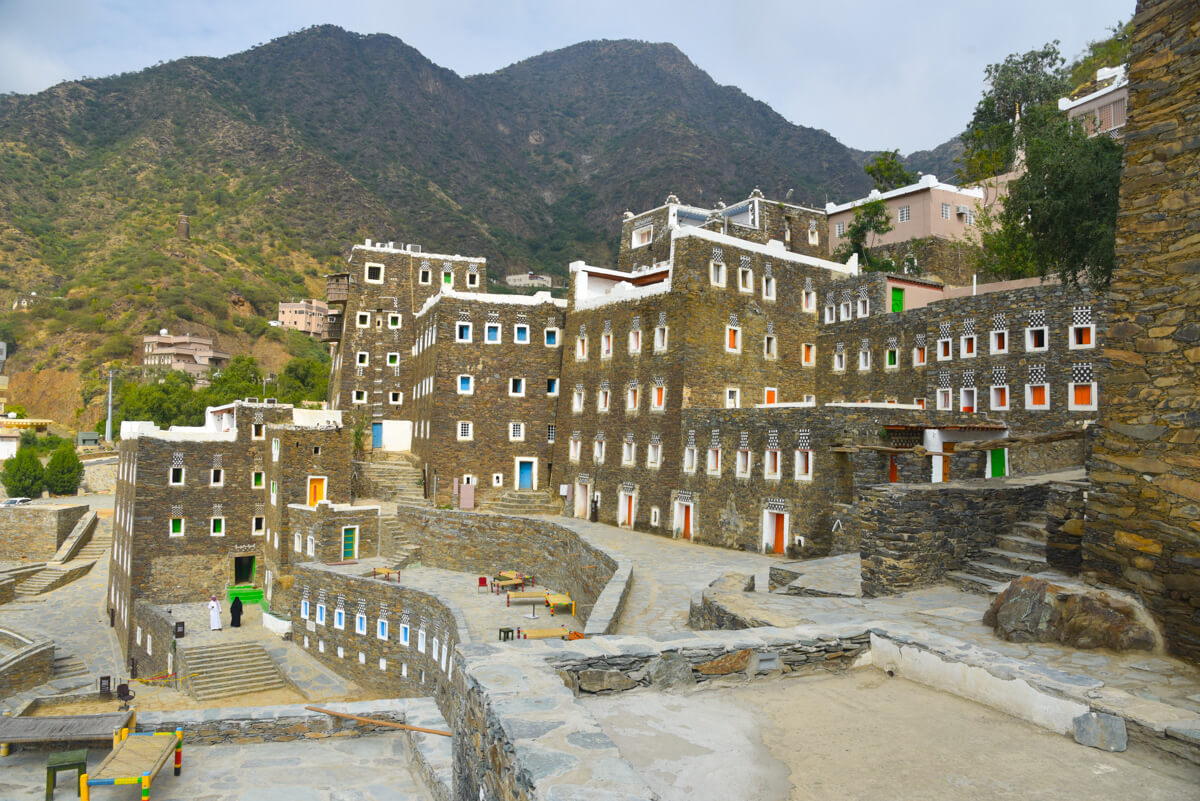
Rajal Almaa, a beautiful village in southern Saudi Arabia – Travel guide to Saudi Arabia
So yeah, the idea of having international visitors who are not expats or workers is still a concept they aren’t familiar with.
However, there is a relatively developed domestic tourism infrastructure, so you can find hotels pretty much everywhere, even though they tend to be expensive.
Moreover, as per things to do, you should know that there are loads, loads of things to do in this country.
I mean, just check its size and you will see that it is bigger than any European country. Here you can check my complete Saudi itinerary.
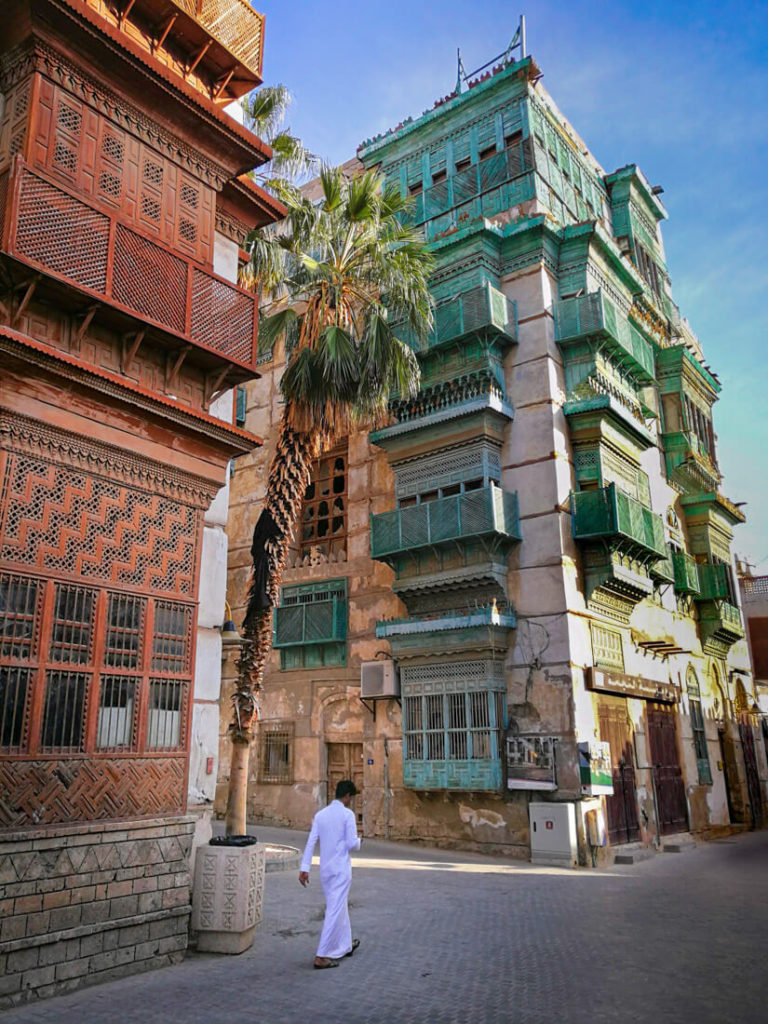
The beautiful Old City of Jeddah – This photo was chosen the 2nd best photo in Instagram by Lonely Planet in January 2019
Is it ethical to travel to Saudi Arabia?
When I came back from Saudi Arabia, I received many, many messages from very upset people who claimed that traveling to Saudi Arabia implicated collaborating with a regime that doesn’t respect basic human rights.
Some messages were from friendly, skeptical people who wanted a response, while others were from really extreme haters who I blocked right away.
Well, let me tell you something: like in any place around the world, you find good and bad people and, when I travel, I don’t meet with Prime Ministers but I visit places and hang out with humble locals.
This is a very long and controversial topic, so I recommend you read my article:
Is it ethical to travel to Saudi Arabia as a tourist?

Hanging out with local friends in Abha
How to access blocked sites in Saudi
Something you should know is that, in Saudi, the internet is censored.This means that some websites might be blocked and inaccessible for regular internet users.Moreover, because of this censorship and, since there is no freedom of speech, the Government reserves the right to monitor your internet activity.Therefore, if you want to access blocked sites and navigate anonymously, you will need something called a VPN (Virtual Private Network).There are several VPNs in the market but the one I personally use and recommend is ExpressVPN, the fastest and the one that works best for Saudi.GET IT HERE AND GET 3 MONTHS FOR FREEIf you have no clue about VPNs, read my tutorial: What is it and how to find the right VPN for Saudi ArabiaTips on how to behave when you travel in Saudi
In Saudi Arabia, the internet is censored, which means that some websites and internet services are blocked. If you want to access them you will need a VPN and for that, I recommend ExpressVPN, the fastest and works best for Saudi. CLICK HERE TO LEARN MORE ABOUT ExpressVPNHeads-up.
Saudi Arabia is the most religious country I have ever been to.
In fact, this is the most religious Muslim country in the world. Everybody knows that.
Most Saudis follow a branch of Islam named Wahhabism, which is characterized for having the most conservative interpretation of Islam and the law of Saudi Arabia strictly follows it.
This means that their penal code includes some very hardcore punishments such as public beheading or getting flogged. This is their country and we are not here to judge and unless you plan to kill someone, smuggle drugs or have sex in public, you shouldn’t be afraid of traveling to Saudi Arabia as a tourist.
Seriously, it is not even close to what you may think.
Saudis prefer to be called Salafis, instead of Wahabis. In their eyes, Wahabism is a few steps ahead than Salafism when it comes to conservatism, meaning that it is really extreme, a term usually used to designate Islamic terrorists. Whereas Salafists are really, really conservative in nature, it is more socially accepted. Thank you, Graham, from Inside Other Places for the clarification
A man reading the Quran is Jawtha Mosque, the second mosque the prophet Mohammed ever prayed at, in Hofuf, east of Saudi Arabia – Can you visit Saudi Arabia?
Some rules you need to follow when you travel to Saudi Arabia
Women need to wear an abaya – The abaya is a local dress that covers your body (not your head).
Some public spaces are segregated by sex – You will figure it out by yourself but some restaurants or cafés are still composed of two areas: men and family section. Women or men that go with women need to sit in the family section. This kind of segregation is slowly disappearing, especially in Jeddah and Riyadh.
Depending on where you are, during prayer time, you can’t be inside shops or restaurants – To be honest, this rule has become more flexible but, outside of Riyadh and Jeddah, they kicked me out from shops during the prayers and I could not even stand in front but I had to walk away. A very weird rule.
Don’t drink alcohol – Drinking alcohol in Saudi Arabia is not legal, not even in 5-star hotels.
Seriously, stay away from drugs – Drugs may lead to death sentence, so don’t play with them.
No public shows of affection – Same as when you travel to Dubai or Qatar.
Don’t say you are an atheist – Even if you were, say you are a Christian or any major religion in your home country. Being an atheist can be considered as blasphemy and this is a very serious crime in Saudi. Moreover, you came to Saudi to meet people and make local friends, so saying you are an atheist won’t help you at all.
On Friday, everything is closed until Asr prayer, which is around 4 or 5pm – Not everything will be closed but some restaurants may open in the morning. However, at noon, during Dhuhr prayer, absolutely everything is closed.
Eat with your right hand, always – This is a generic Muslim rule but in Saudi is particularly strict. If you are sharing a meal with more traditional people, try to always eat with your right hand. I am actually left-handed and sometimes I forget about it and Saudi has been the only place where the locals got a bit upset when they saw me eating with my left hand.
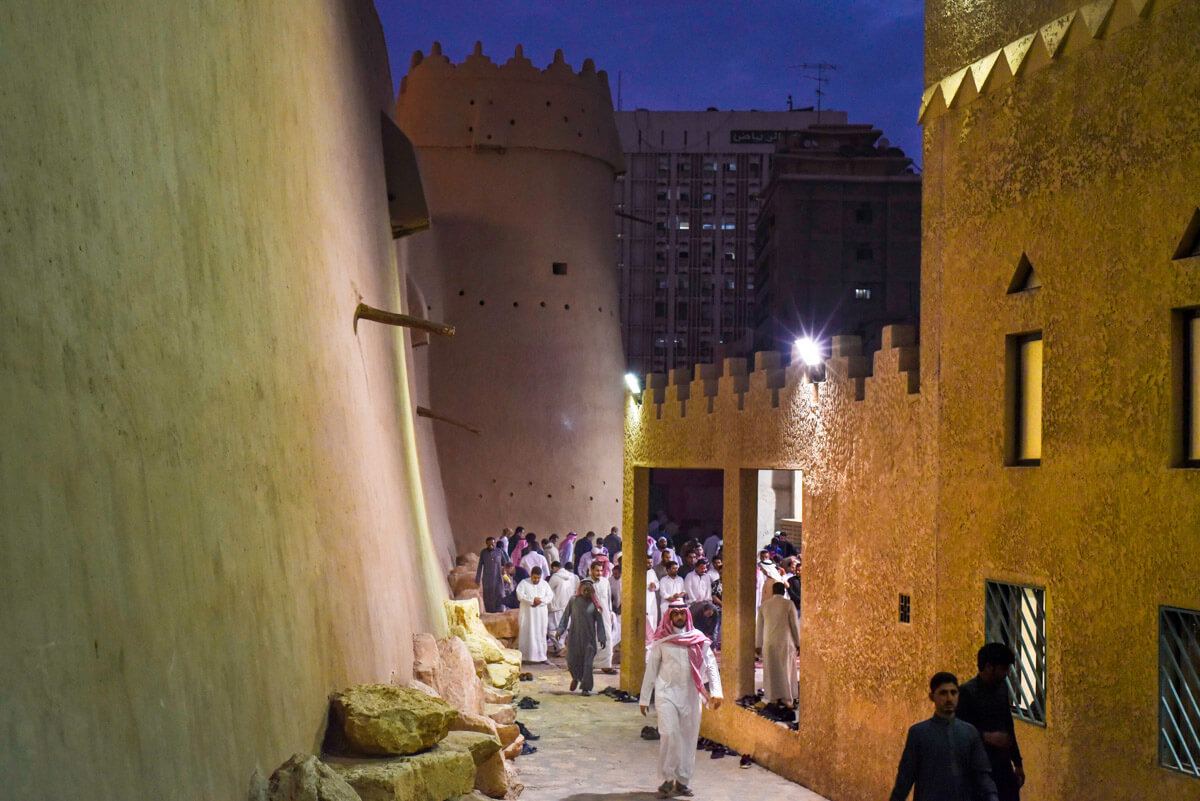
The Old City of Riyadh – Saudi Arabia travel tips
Misconceptions about Saudi Arabia – Things you can actually do
Like I said before, in the last couple of years, the laws of Saudi Arabia have become more flexible. Well, this is not entirely right. According to my local Saudi friends, some laws haven’t been changed but the religious Islamic police (mutaween) has lost power, so they aren’t controlling what people do anymore.
Men and women who aren’t family related can hang out together, in public – Some years ago, you couldn’t go to a restaurant or a café with a friend from the opposite sex but now you can do it normally, like in any other country.
Foreign women can travel around the country independently, and alone – I have already lost count of all the women who asked me if they can go there by themselves. Yes, you can travel to Saudi Arabia as a woman, by yourself. Would it be challenging? It would be different from being a man, indeed, but it is definitely legal.
Single foreign women can also visit Saudi on a tourist visa – You can travel to Saudi with your unmarried boyfriend and even if you are single, no problem.
Women don’t need to wear hijab – You don’t need to cover your head but, like I just said, you must cover your body with an abaya. If you travel to Iran, you will see that the clothing rules are even more strict.
Women can drive, including renting a car – From June 2018, women can finally drive and, as a female tourist, you can also rent it.
Men can wear shorts – Nobody will say anything to you.

with @nadaalnahdi and @esraarayes – Can I visit Saudi Arabia
The people and the culture – The Saudis
Like in many countries in the Middle East, in Saudi, you find loads of particularly kind people.
Typically, Saudis are so easy to recognize because they wear the thawb, which is the white traditional dress. They also cover their heads with the ghutrah, which can be of different colors but red & white seems to be the most commonly used.
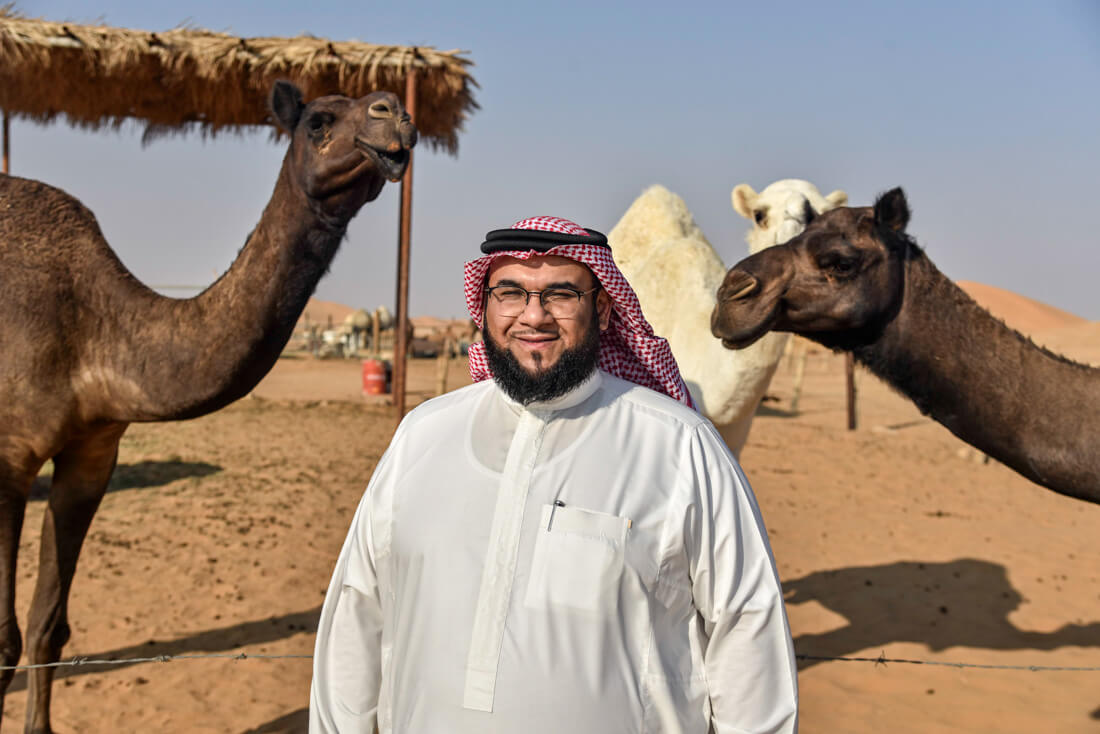
A Saudi man – Can tourists visit Saudi Arabia?
Language in Saudi Arabia
Arabic is the official language. English can be a sometimes problem when you travel in Saudi Arabia, as most people don’t speak it but you will always find someone who does.
Religion in Saudi Arabia
According to the Saudi Government, 100% of the Saudis are Muslim, the large majority being Sunni Wahabbis. There is a large Shia population, as well. Remember that Saudis are very conservative, so try to be respectful and sensitive.
Hospitality in Saudi
Before traveling to Saudi Arabia, I knew a lot of people who had been there on a business visa and the truth is that I am extremely disappointed with all of them because they had told me:
Saudis are arrogantSaudis are racist to anyone who is not from the GulfThere is nothing to do in SaudiSeriously, I don’t know where they have been but, from the moment I met the immigration officer who stamped my passport with a big smile while he tried to improve his Spanish, I have just had positive experiences with Saudi people.
Saudi people are extremely hospitable. From endless coffee and meal invitations to random people who insisted on showing me around the city, I seriously met some incredible locals, some of whom I can call now friends.
Honestly, the experience was no different from the blessings of hospitality in PakistanOman or Iran, no kidding. I shared many short moments with so many locals but there were two Saudis in particular who really changed the perspective of my trip.
First, I met Abdullah, an English teacher from Kharj. He picked me up when I was hitchhiking and drove me to a city that was 80km away (and it was not his way). There, we met with one of his friends, we had lunch at his house and then we visited his camel farm.
Abdullah taught me many interesting things about Saudi culture, especially their interpretation of Islam.
Do you like extreme destinations? Read: How to travel to Syria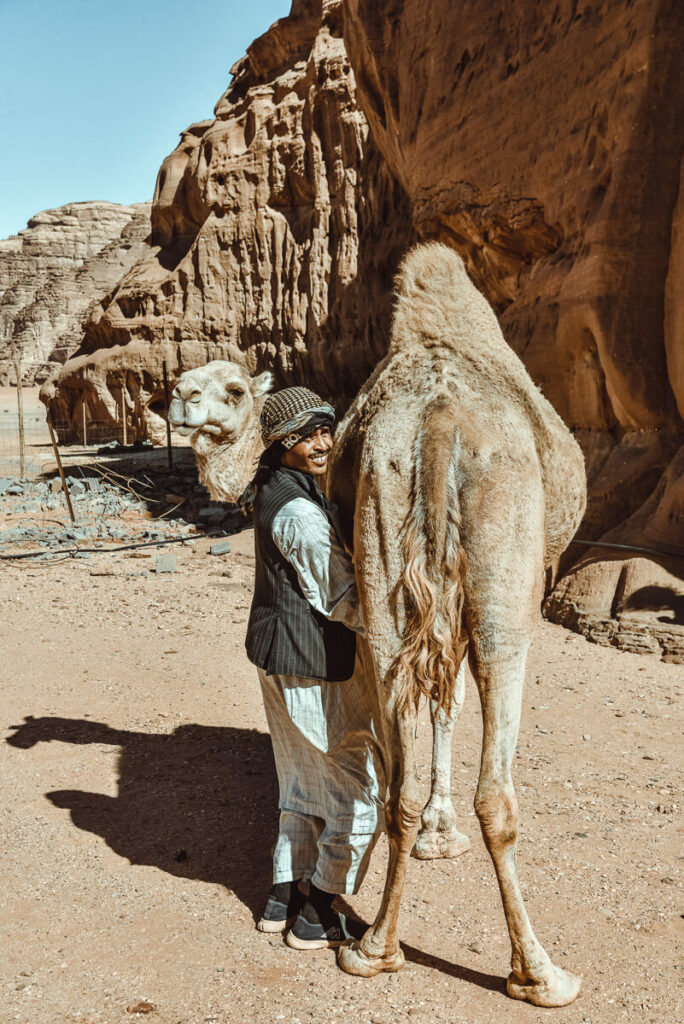
Saudi Bedouin milking a camel
A few days after, I met Ibrahim, a real Saudi from Abha. We met at the souk of Abha and, after having a chat, he invited me to his famous village named Rajal Alma.
We had dinner, stayed at his friend’s house and showed me around on the day after. Ibrahim comes from a very traditional Saudi family (his father was actually a famous Imam from the region) but he married a Filipina girl, something quite unheard of from Saudis with a similar background.
Seriously, don’t trust anyone who has just been to Jeddah or Riyadh for business. First of all, you can’t judge a country by the inhabitants of a several-million people city.
And second of all, don’t trust the judgment from someone who has traveled to Saudi Arabia for business because he hasn’t seen much beyond the office, the fancy restaurant, and the hotel.

Saudis are not happy about how the Western media portraits them
Our media doesn’t really do justice to Saudi people, as they portray them as religious fanatics who force women to submit to their Sharia rules.
The reality is miles away from this stereotype.
Like in any country, there are loads of awesome people and, like in any off the beaten track Muslim country, most of them are extra-nice with foreigners.
Local Saudi women
Most women in Saudi wear the black niqab, which covers the whole face except the eyes.
The reason they wear it is that, according to their interpretation of the Quran, women can’t show their face to any man who isn’t their dad, uncles, grandfathers, sons, and husband, of course.
For years, many pro-feminist groups in Europe have been claiming that the use of niqab is sexist, against the women’s rights and they wear it against their will.
Whereas I fully understand their point, I think that their argument is quite simplistic and it just lets you see one tiny side of the whole picture.
Please note that I am not trying to justify the use of the niqab but I just wanted you to know that many Saudi women actually choose to wear it. Really.
They choose to wear it because they think that this is the right thing to do because the Quran says so. They believe they need to wear it as much as men believe it.
Obviously, there will be many cases of liberal Saudi women who will tell you a different story but I am just talking in generic terms.
My point is that this topic is way more complicated than we think and, as tourists, we shouldn’t be talking or trying to change it because you are traveling to Saudi Arabia to learn about their culture and visit beautiful places.
How to deal with women in Saudi
Now that every day you see more and more women working in public spaces, you are likely to talk to quite a few Saudi women who wear the niqab.
If you are a man, don’t try to shake hands and keep a reasonable distance with them but you can talk to them freely and you will see that they are as lovely women like any other.
If you are a foreign woman, they will definitely be extra nice to you and, if you are on the countryside, expect them to invite you to their house.
When I visited Al-Jawf, 1,000km north of Riyadh, I went there to work on an assignment for a local company and I was very lucky to be received by two super nice ladies wearing niqab. I spent the whole day with them.
They showed me around their province, we went to have some coffee and I even went to their house where they fed me until I exploded. They were as hospitable as any Muslim man I had met before and the only difference is that I didn’t see their faces. It was an enriching experience.
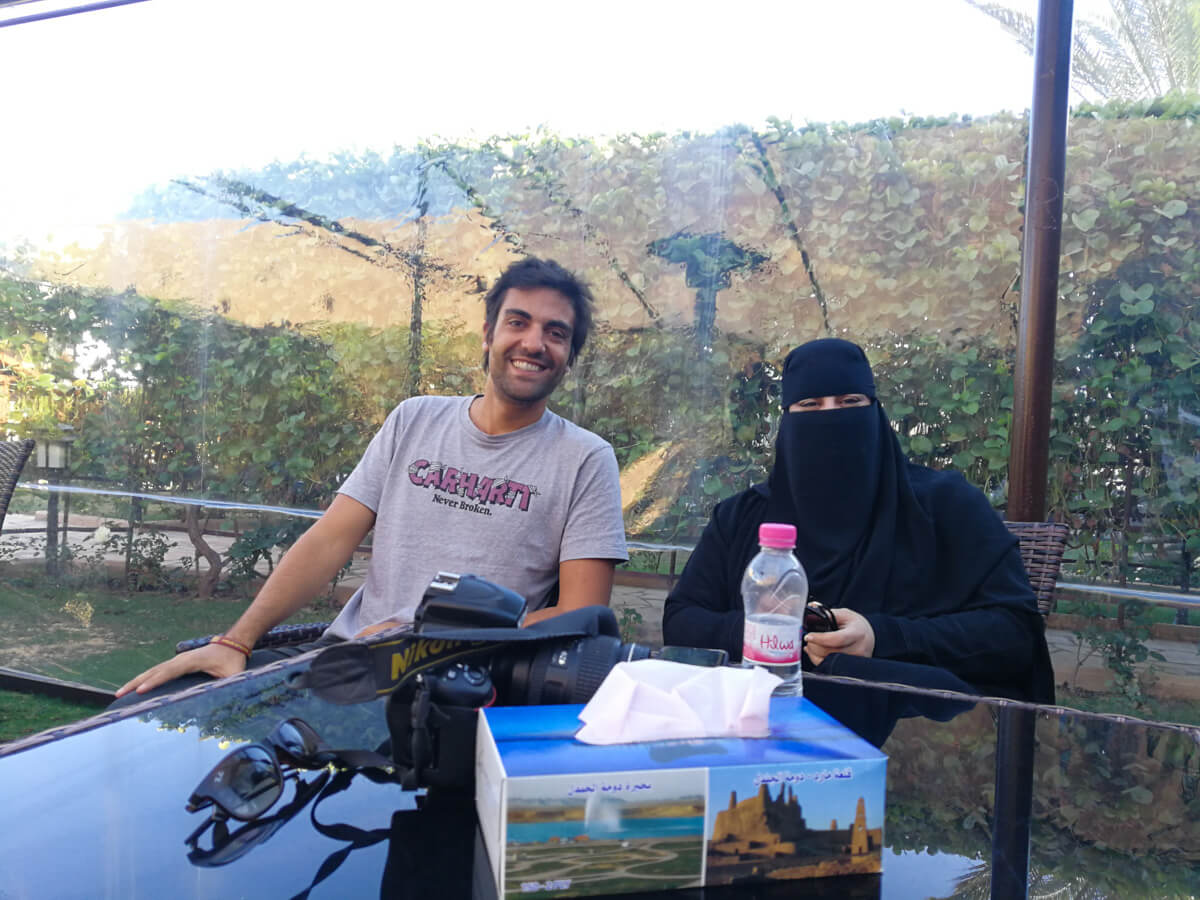
Chilling with a Saudi woman in Al-Jawf – How to travel to Saudi Arabia?
Saudis are multi-ethnic
For centuries, Muslims from all over the world came to Saudi on their journey to Mecca and, at some point, decided to settle there.
Over time, they became Saudi citizens and that is why, today, you find Saudis from all types of ethnicities.
From Bedouin to East-African-looking people and even the cultural-Yemeni-like people from the south of the country, in Jizan, Saudi is the most multi-ethnic Arab country.
For me, this was one of the most surprising things about the country.
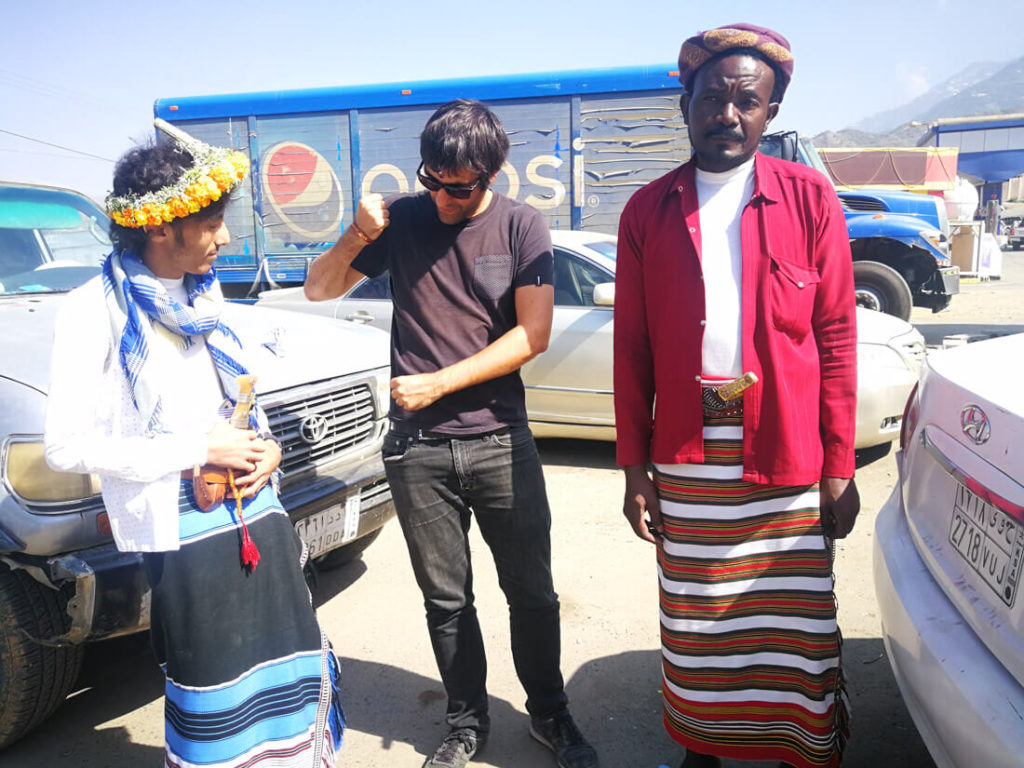
People in Fayfa, Saudi Arabia
Food when visiting Saudi Arabia
The food was another extremely surprising thing about traveling in Saudi.
Before visiting Saudi, I was traveling in Oman for 1 month. In Oman, I felt that, after day 2, I had already tasted all the local food, which was always simplified to different variations of rice with meat, chicken or fish.
Then, I tasted one or two different local dishes in some houses and the rest was all Indian food.
Saudi, however, is a different story. Since it borders with so many Arabic countries, its huge dimensions with many different geographical areas and its multi-ethnic population, the food in Saudi Arabia is a real blend of all the Arabic food you can think of.
From the Yemeni food-like dishes from the south to the olive oil-rich food from the north of the country, Levantine Arabic dishes such as vine leaves and makluba, foul and hummus for breakfast and, of course, the classic Gulf food that includes all sorts of rice with meat, the cuisine of Saudi Arabia also shows the cultural richness of the country.
By the way, traditionally, Saudis eat on the floor and use their right hand to eat. Eating like them is a sign of respect but if you are struggling, you can always help yourself with a spoon.
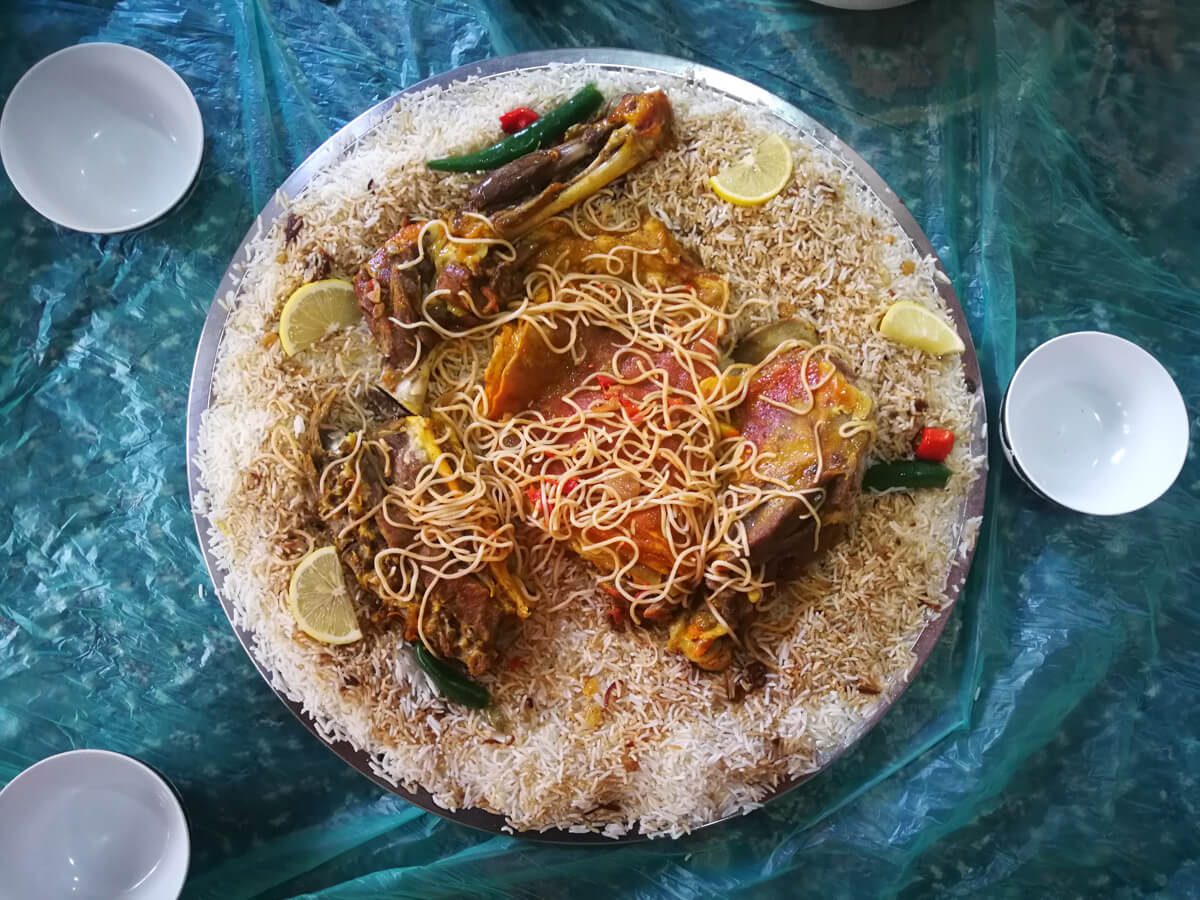
– This is mandi, which is originally from Yemen – Travel tips for Saudi Arabia
Solo female travel in Saudi
Remember to get travel insurance for Saudi Arabia Saudi Arabia’s health care is extremely expensive, so insurance is a must. IATI Insurance offers different plans, for all budgets. Get your 5% exclusive discount if purchasing via this linkSince I left Saudi Arabia, I have been bombed with tons of questions from many women who are skeptical about traveling to Saudi.
Sure, Saudi is an extremely patriarchal country, so this kind of reaction is perfectly understandable. However, let me tell you that, as a woman, Saudi Arabia is much safer than you could ever think.
I am perfectly aware that, since I am not a woman, my opinion doesn’t really count here but, luckily, during my journey, I met Nada al Nahdi, a Yemeni / Indonesian girl who was born in Saudi, so she knows the people and culture very well and has traveled around the country extensively.
Nada wrote an article about this topic on my site, so if you want to know more, read:
9 misconceptions about traveling to Saudi Arabia as a woman.
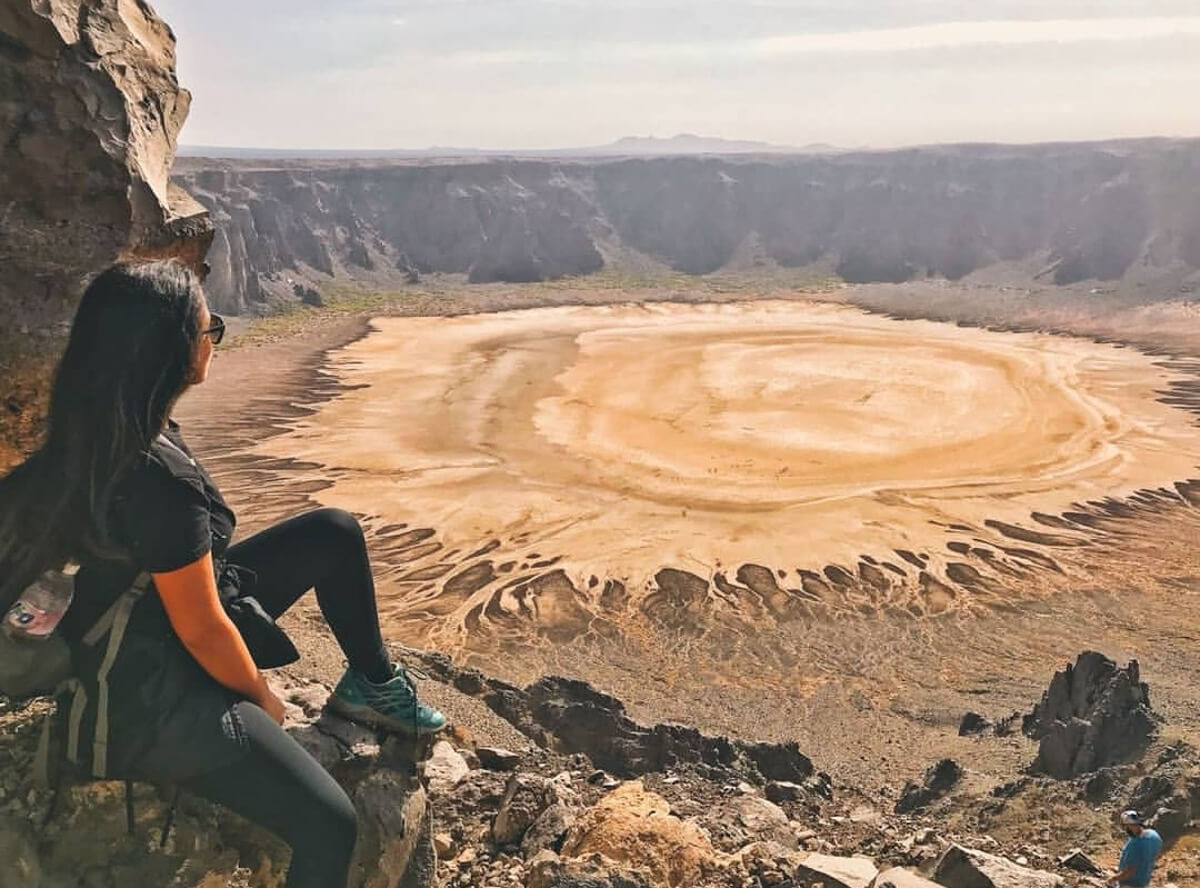
Nada trekking in Saudi Arabia
Is it safe to travel to Saudi Arabia?
From a crime perspective, Saudi Arabia is just another very safe place to visit in the Middle East. I mean, you should always be aware of your belongings but pickpocketing or being robbed is quite unheard of.
As per terrorism threat, I will not deny the fact that there have been some one-off terrorist attacks but even UK travel advice says that, except for the areas close to the Yemeni border, all Saudi Arabia is safe to visit.
However, I also went to Jizan, the region bordering Yemen and everything was extra peaceful. The war is happening on the other side of the border, not in Saudi.
In my opinion, the only actual threat when traveling in Saudi Arabia are the extremely crazy drivers. Seriously, after all my years of travels, I can now confirm that Saudi people are the most insane people on wheels.
For a more detailed analysis, read this article from Joao Leitao: Is Saudi Arabia a safe country to travel?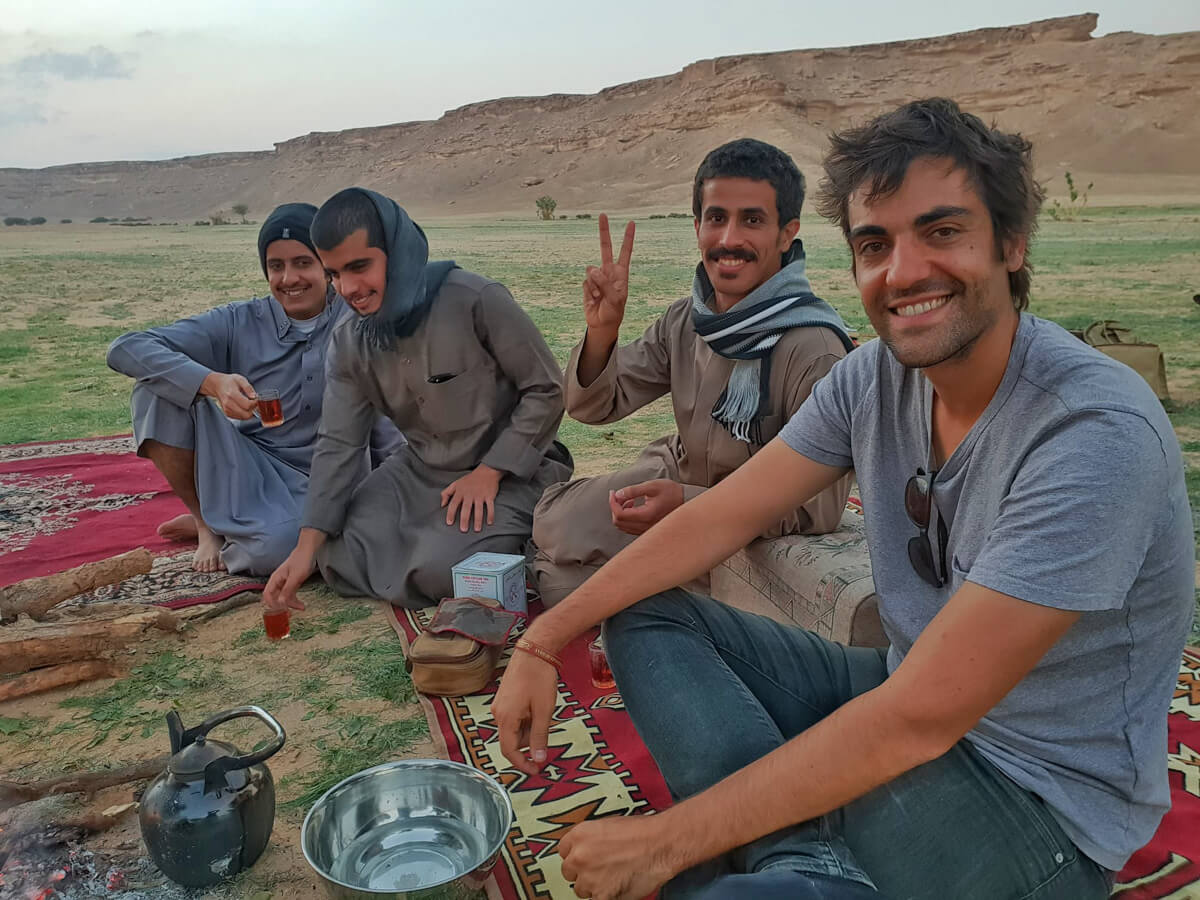
Hanging out with some Saudis – Photo by @joaoleitaoviagens – Travel tips to Saudi Arabia
Money, budget and costs in Saudi Arabia
The Saudi Rial is the official currency and:
1USD = 3,75SRExchanging money
Euros, United States dollars or British Pounds are widely accepted. You can even exchange Indian and Pakistani rupees and other Asian currencies, as there is a large Asian population living in Saudi.
Of course, the currencies from other Gulf countries, such as Omani Rials or UAE Dirhams are also accepted.
TM and credit cardsATMs are available pretty much everywhere and credit cards are accepted in most modern cafés, restaurants, and hotels. However, bring always some extra cash, as the Indian-run cafés and other more local places don’t accept cards.
How much does it cost to travel in Saudi Arabia?
These are the prices of the most typical things:
Budget Hotel – Double room from 100 to 150SR (26 to 40USD)Breakfast in Indian-run café – 5 to 10SR (1.30 to 2.60USD)Breakfast in local Saudi eatery – 10 to 15SR (2.60 to 4USD)Lunch in Indian-run restaurant – 10 to 15SR (2.60 to 4USD)Lunch in local Saudi eatery – 15 to 20SR (4USD to 5.30USD)Lunch in mid-range restaurant – From 30-35SR (8-9USD)Short taxi ride in Riyadh – 15 to 25SR (4 to 6.60USD)Transportation: How to move around when visiting in Saudi Arabia
Something you need to know: Saudi Arabia is the least walking-friendly place I have ever been to. That being said, here is what you need to know regarding moving around the Kingdom:
Moving inside cities
Public transportation in Saudi cities is awful and, except in some parts of Jeddah, you must drive with your own car or by taxi. You can’t seriously walk.
If you aren’t self-driving, I recommend you download Uber or Careem, so you won’t have to deal with negotiating a price with a taxi.
Domestic flights
Another problem of Saudi Arabia is that distances are ridiculously huge and the nice places to visit in Saudi are scattered all around the country.
For example, Al-Ula is nearly 1,000km north of Jeddah and Jizan is another 1,000 south of Jeddah. If you are short of time, a very good alternative is taking domestic flights.
I recommend you check on Saudia Airlines, as they have the largest number of domestic connections in the country.
For cheaper flights, check Flyadeal.
Actually, the most effective way to travel in Saudi Arabia would be taking a domestic flight and then renting a car in the destination itself.
Renting a car in Saudi Arabia
Road tripping around Saudi Arabia is the best way to enjoy the country, and I strongly recommend you do that.
Gas is cheap, so are the daily rental rates. However, all companies offer limited daily mileage, around 250-300km a day I think, so if you drive to faraway places like Al-Ula or Jizan, it can get expensive for solo travelers.
By the way, most rental companies won’t rent you a car if you don’t have an international driving license, so remember to convert it before leaving your country.

Some roads in Saudi are insane. This is Tabouk region
Moving around Saudi Arabia by bus
You can also move by bus between cities. They are very cheap but the problem is that you will have to rely on taxis once you get to any destination. There is not a single city in Saudi which is walking friendly.
You check all bus schedules and buy tickets on this website.
Hitchhiking
As crazy as it may sound, I hitchhiked all across Saudi Arabia.
I actually hitchhiked from Riyadh to Jizan, 1,300km. I had some really good experiences but, at the same time, I had not so good experiences.
On the one hand, it is relatively easy to get a ride and, normally, Saudis will be extremely helpful and, if you are lucky, they will invite you to their house.
On the other hand, most places in Saudi are connected with highways where people drive extremely fast and, sometimes, they overtake cars by the shoulder of the road, which is extremely dangerous if you are waiting there.
Moreover, many Saudis are crazy drivers, more than in any other country I have been to. On one occasion, I refused to continue with a man because I was seriously afraid of dying. When I finally reached Jizan, I decided not to hitchhike anymore. It was too intense.

We had some issues when hitchhiking with these guys – Can I travel to Saudi Arabia alone
Internet and SIM Card
Connecting to Wi-Fi in Saudi
Saudi is a modern country, with pretty good Wi-Fi in most places.
Getting a SIM Card in Saudi
I got ZAIN which, according to locals, has the worst network but it was the only company I found which you could buy just 1 or 2GB. Mobily is the most popular one but they asked me to buy 10GB, at least, which was around 150SR (40USD). With ZAIN, I think I just paid around 30SR for the SIM Card plus 1GB worth of data.
Remember that, in Saudi, the internet is censored and, if you want to access blocked sites, you will need a VPN. Read: How to find the right VPN for Saudi Arabia ccommodation: where to stay in SaudiIn Saudi Arabia, there is plenty of accommodation options.
Typically, budget hotels will be apartment-style hotels, which tend to be a very good value-for-money option when you are two people or more.
In Jeddah and Riyadh, good but basic apartment-style hotel will start at 50-60USD a night, approximately, while in smaller towns, you can find for 30USD.
Read: How to find the right accommodation in Riyadh
Like in any Gulf country, luxury hotels abound in Saudi, especially in big cities.
CLICK HERE TO FIND THE BEST HOTEL DEALS IN SAUDIMore information for traveling to Saudi
Remember to get travel insurance for Saudi Arabia Saudi Arabia’s health care is extremely expensive, so insurance is a must. IATI Insurance offers different plans, for all budgets. Get your 5% exclusive discount if purchasing via this link ll guides and articles for traveling in Saudi Arabia destinationTravel Guide to RiyadhWhere to Stay in RiyadhSolo Female Travel Guide to RiyadhIs it Ethical to Visit Saudi Arabia as a TouristHitchhiking and Backpacking in Saudi ArabiaVPN for Saudi ArabiaSaudi Arabia ItineraryTravel guides to other countries in the Middle East
Iran Travel GuideIraq Travel GuideTravel Guide to OmanTravel Guide to LebanonSyria Travel GuidePalestine Travel GuideYou will also be interested in: Where in the Middle East is safe? and The most beautiful places in the Middle East.
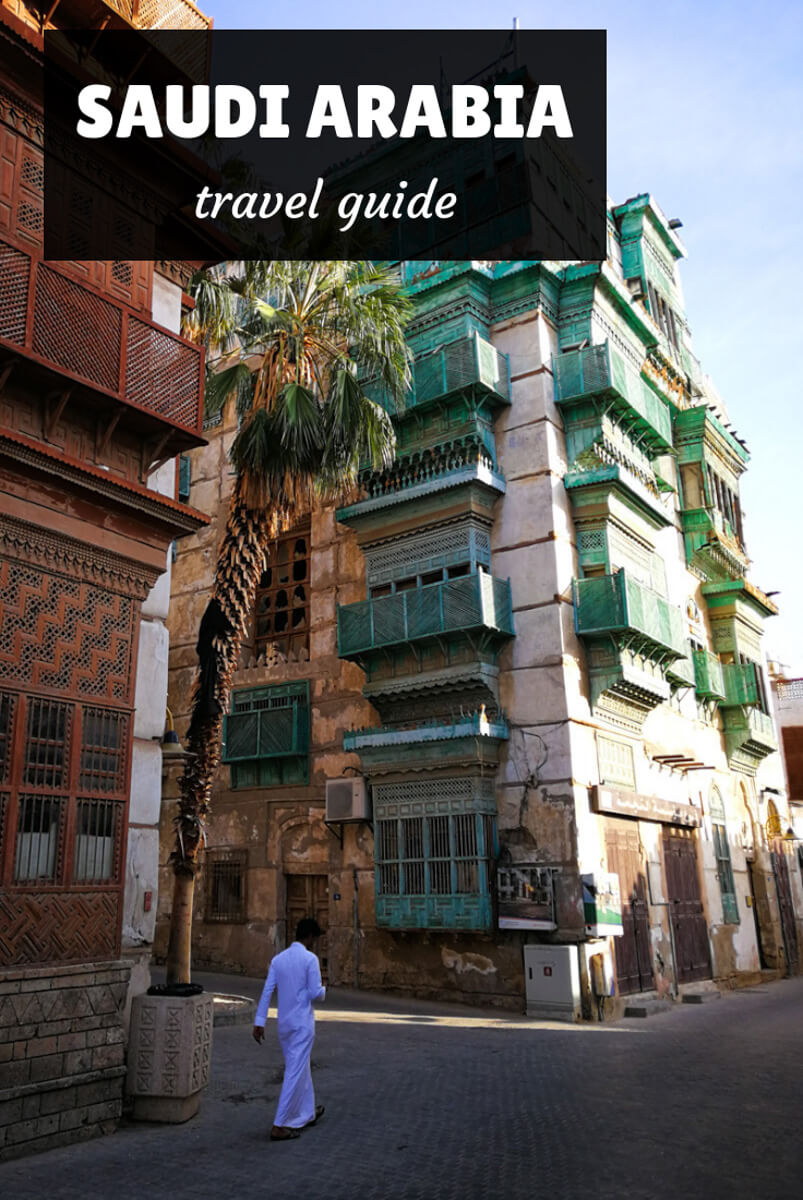
-
By: Joan Torres
Title: Tips and how to travel to Saudi Arabia in 2022
Sourced From: againstthecompass.com/en/travel-to-saudi-arabia/
Published Date: Tue, 23 Aug 2022 06:00:00 +0000











